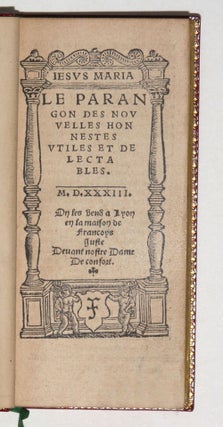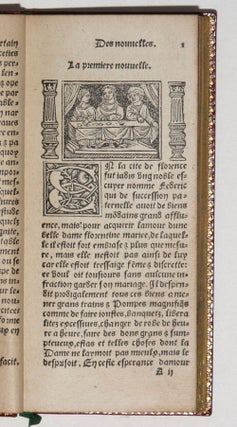Le Parangon des nouvelles honnestes utiles et delectables.
8vo, [14 x 6.3 cm], Long & narrow (‘agenda’ format), (1) f., 80 ff., woodcut architectural title border incorporating printer’s initials, 29 small woodcuts flanked by columns, black-on-white woodcut initials. Bound in 19th-century red morocco gilt by Trautz-Bauzonnet, gold-tooled green morocco doublures, marbled endpapers, all edges gilt, in a pale blue chemise with green morocco spine label. Binding pristine, with the fine exlibris of its previous owners affixed to the front flyleaf. A 1-cm paper flaw at f. 38 affecting a few letters, very faint uniform browning.
Only recorded copy of a very early illustrated edition (3rd) of this anonymous collection of ‘nouvelles,’ a literary genre presenting brief prose narratives taken from bourgeois life. The Parangon des nouvelles honnestes utiles et delectables, following the famous Les cent nouvelles nouvelles (c. 1460), collected vernacular tales purporting to be both true and current (i.e., relating to recent events, hence ‘nouvelle’) and so eschewed more established prose forms which relied on classical mythology, historical exempla, chivalric fantasy, and animal fable, in favor of reports on greedy merchants, drunken millers, lascivious housewives, and the like.
Largely derived from the Decameron of Boccaccio, Lorenzo Valla’s Apologues, Poggio Bracciolini’s Facetiae and the anonymous Germanic Ulenspiegel, the Parangon packaged together old and new for popular consumption, resulting in what one scholar has called “a magma ready for every kind of metamorphosis” (Pérouse [1977], p. 7), that is to say, the unformed raw material that soon would cool into the more recognizable and longstanding genres of the novel and short story. These “issues of novelty, fictional accreditation, historical veracity, and the chivalric narrative past […] were also played out in a variety of other critical settings encompassing works both of shorter and longer fiction,” most famously in François Rabelais’ proto-novels Pantagruel (1532) and Gargantua (1534), exact contemporaries of the Parangon (G. Norton, p. 306). Often bawdy and salacious, the nouvelle was initially overlooked by scholars of early-modern literature, but today its status as a “non-mimetic, self-conscious, intertextual, ironic, perhaps even skeptical mode of writing” has cemented it as a pivotal precursor to a modern literary sensibility (LaGuardia, p. 16). In short, the nouvelle frustrates and delights scholars today much as it did its contemporaries, and its importance springs from the uneasy, active reading it requires from its readers.
The present volume’s tall and slender ‘agenda’ format – a shape associated with easy portability and personal use – is very rare in this period, occurring (when it does) almost exclusively in French Books of Hours, a genre which blends private devotion (prayer) with a need for constant practical reference (liturgical hours, calendars) (see the Heures printed by Antoine Chappiel [1504], Pierre le Dru [1505-6], Gillet Hardouin [1509 and 1515], T. Kerver [1514], and Germain Hardouin [1534 and 1526]; a notable secular exception is the Manuale Vergilianum [Strasbourg, Johann Grüninger, 1507-10?]). It is intriguing that the impious, casual tales of the Parangon should have been printed in a physical format with such pious overtones: does its unusual form merely result from a desire for easy practical use, or does it carry some surplus of ironic meaning? Even the book’s program of illustration participates in an (oddly modern) mixing of material: its numerous woodcuts are quite clearly borrowed from other (still untraced) sources: figures seated at dinner, a scholar with his amanuensis, women spinning yarn, a statue of Mars, a monk preaching in his pulpit, lovers embracing, a man drunk on wine, a mourner bent over a shrouded corpse, a Janus-faced figure, a sword duel – these all invite readers to puzzle out how such images might relate to each other and to the texts they supposedly elucidate. Like the nouvelles themselves, the illustrations would seem primarily to “take their meaning from their relationship to one another” (LaGuardia, p. 3).
OCLC and KVK locate no copies of this 1533 Juste edition. The 1531 Morin edition, which is the earliest recorded, is located at the BnF, while the 1532 Morin edition is held by Princeton, the Bayerische Staatsbibliothek, and the Biblioteca Civica Attilio Hortis (Trieste). Both Morin editions contain a different program of woodcut illustrations, based on Virgil, than the Juste edition offered here.
* Brunet IV, 364-65 (citing this copy as ‘un somptueux exemplaire’ of ‘un livret fort rare’); Bechtel P-16; Bibliographie des livres imprimé à Lyon an Seizième Siècle, IV, P.203, no. 13; A. Pettegree, French Vernacular Books, no. 43031; Émile Mabille, Le parangon des nouvelles honnestes et delectables (Paris: Jules Gay, 1865). Gabriel A. Pérouse, Le parangon de nouvelles (Paris-Geneva: Droz, 1979); Gabriel A. Pérouse, Nouvelles françaises du XVIe siècle: images de la vie du temps (Geneva, Droz, 1977), p. 69 ff.; J. Koopmans and A Verhuyck, “Le Parangon de nouvelles…,” Bibliothèque d’Humanisme et Renaissance, vol. LXI, no. 1 (1990), pp. 97-9, 104; W. Kemp, “Les petits livres français illustrés de Romain Morin (1530-1532) et leurs dérivés immédiats,” in A Possenti and G. Mastrangelo, eds., Il Rinascimento a Lione: Actes du Colloque de Macerata (6-11 mai 1985), (Montreal, 1988), pp. 465-525; G. Furguson and D. LaGuardia, eds., Narrative Worlds: Essays on the Nouvelle in Fifteenth- and Sixteenth-Century France (Tempe: Arizona Center for Medieval and Renaissance Studies, 2005); D. F. Foxon, “Some notes on the agenda format,” The Library, vol. 8 (1953), pp. 168-70; Glyn P. Norton, “Theories of prose fiction in sixteenth-century France,” in The Cambridge History of Literary Criticism: Volume 3, The Renaissance (Cambridge: Cambridge University, 1999), pp. 305-13.
Price: $31,500.00



